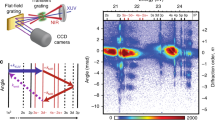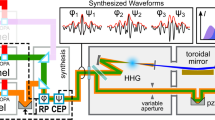Abstract.
The third harmonic of 810-nm 100-fs pulses at 130 μJ is generated very efficiently when ultrashort pulses from two noncollinear beams interfere in an optical medium to create an instantaneous transient grating via the optical Kerr effect. The grating couples two pathways for third-harmonic generation, each taking two photons from one beam and one photon from the other beam, respectively. The coupling enables self-phase matching in the complete process, resulting in a conversion efficiency of ≈3%. Scattering an independent beam at the transient grating confirms a lifetime limited by the pulse duration, with a reaction on the order of one optical cycle. Using the second harmonic of a Ti-sapphire laser at 405 nm, it is shown that the generation of the transient Kerr grating is a general feature, requiring less than 20 μJ/pulse. By introducing a third femtosecond beam we are able to emulate various digital logic units with femtosecond response.
Similar content being viewed by others
Author information
Authors and Affiliations
Additional information
Received: 16 October 2001 / Published online: 6 June 2002
Rights and permissions
About this article
Cite this article
Reif, J., Schmid, R. & Schneider, T. Femtosecond third-harmonic generation:. self-phase matching through a transient. Kerr grating and the way to ultrafast computing . Appl Phys B 74, 745–748 (2002). https://doi.org/10.1007/s003400200847
Published:
Issue Date:
DOI: https://doi.org/10.1007/s003400200847




